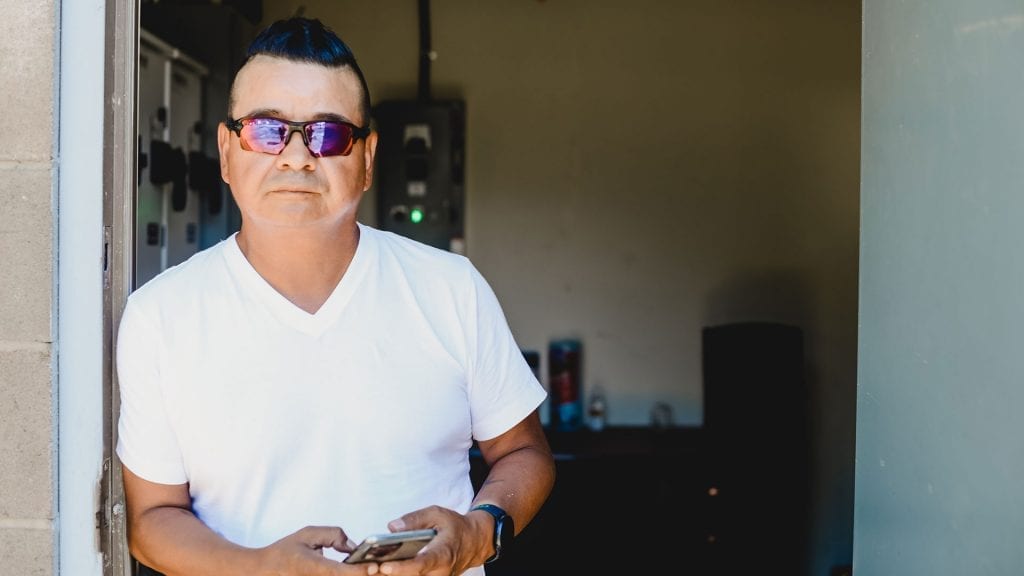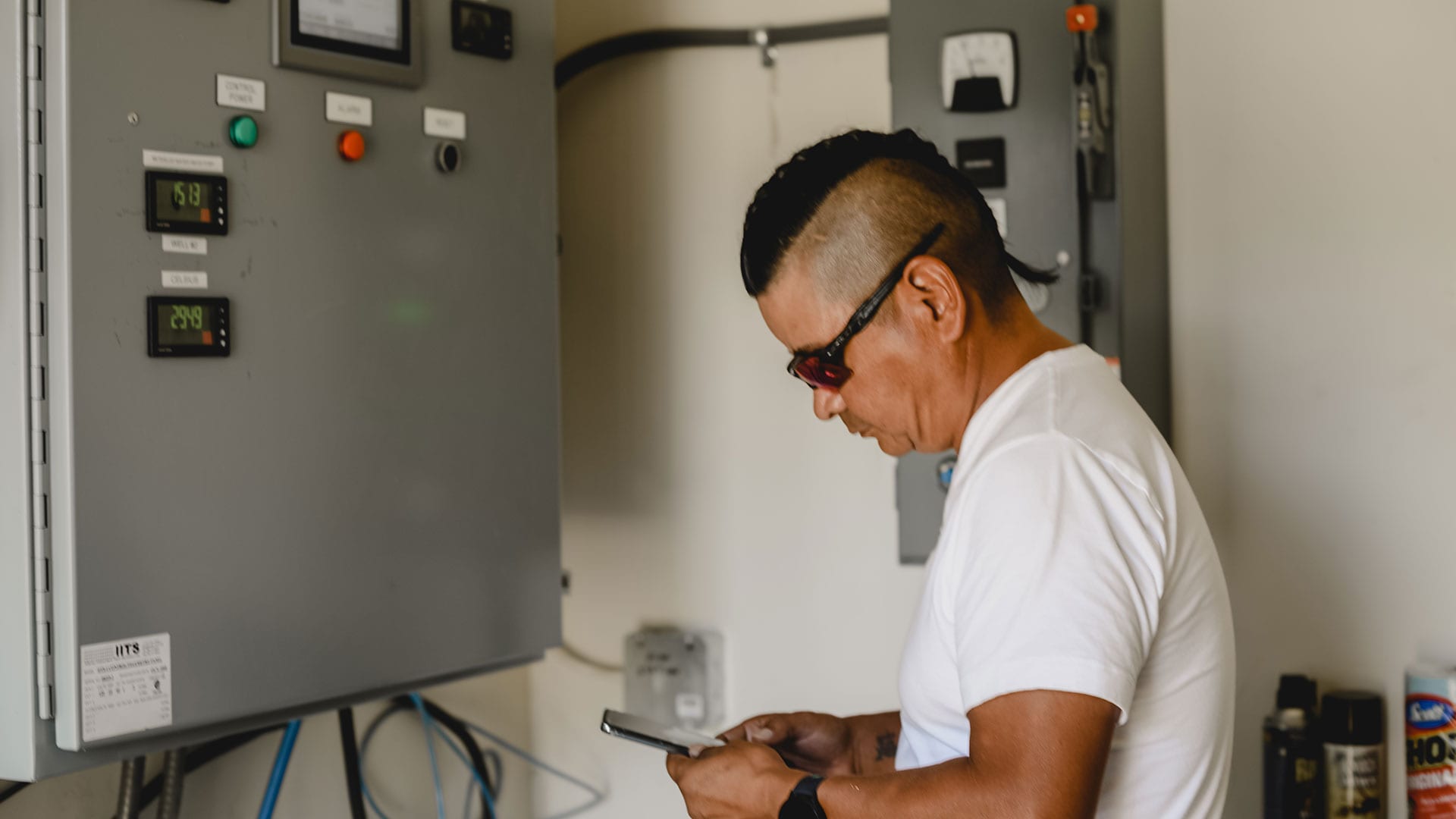
Trever Andrew, a Secwépemc man, took 15 years to develop an app designed to allow Indigenous communities to regain control of their water data. Photo: Kelsie Kilawna/IndigiNews
In Secwépemc territory, overlooking Little Shuswap Lake, is the small First Nations community Adams Lake Indian Band (ALIB).
Trever Andrew, a water and wastewater operator for ALIB, begins each day by monitoring the data of the community’s water and wastewater facilities entirely from his phone through an app he created.
Sewllkwe Book is an app-based water management program. Its name translates to “water book.” Created by the Secwépemc innovator, it provides users real-time information on water quality and usage.
There are currently 61 long-term drinking water advisories in First Nations communities throughout Canada, which means they have been in place for over a year. Although the federal government committed to ending these advisories by 2021, progress has been slow. In 2019, however, the government committed $739 million over five years for drinking water and wastewater, and to help eliminate and prevent these advisories.
Andrew says Sewllkwe Book is his way of bringing more of this data directly to First Nations communities so they can be better informed.
What the app offers
“When I built the program, I built it to scientifically tell our story,” says Andrew, who spent 15 years developing the app.
Sewllkwe Book includes data tailored by Andrew for ALIB’s unique water systems, he says. Each community’s water management staff can customize the program to notify users based on any of the indicators they choose.
Some of these features include logging and tracking inventory needs, budget planning, maintenance task reports and an alert for whether an eye wash station has been turned on in the water facility.
Meant to serve as a record of a community’s water quality, Sewllkwe Book provides instant reports on water quality data and identifies water quality issues, according to a media release. It can report on the condition of drinking water in any system that is being tested, whether it’s from a tap or a stream.
“I developed the program because I got tired of waiting for a proper water program and wastewater program,” says Andrew. “I couldn’t do my job. I was not in compliance.”
According to the B.C. Ministry of Health, all water operators must use “good record-keeping practices” to show compliance with their local health authority’s regulations. This means, for example, in the instance that someone says they were harmed by the water supply system, the water operator’s records can “show the steps taken to avoid harm.”
“By showing where water quality issues may be developing, operators can take corrective action, saving more costly expenses, and residents can consistently receive higher quality water,” says Andrew.
In a media release, he says, “For those wanting to upgrade a system, the data can identify where money should be spent to achieve the best result. This data can be used to approach senior governments for funding water system improvements.”
Currently, the Okanagan Indian Band and ALIB have the program installed and tailored to their community’s water system. The cost to bring the software to new communities starts at $12,000, plus a $4.99 annual fee for each person using the app, according to the release.
Andrew says Sewllkwe Book may be able to change the health outcomes of many Indigenous communities by providing instant community-wide notifications on water quality.
“This is what … I like to call isolated data. And that means the people I need [to] communicate to do not see this,” Andrew says, while pointing at the data screen in one of the ALIB water facilities.
“I created a program which allows everyone to see this data. Adams Lake invested in the program. So that means now the community can buy the app to see what’s going on in your water systems.”
Community health outcomes
Sewllkwe Book creates instant reports when something goes awry in any community water system, says Andrew. For example, if a water line breaks in the community and the water needs to be turned off to repair this, the water management staff will know how much water is left in the community reservoir and how much is available for consumption.
“Half of it is getting the right data to the right people,” says Andrew. “I have all these notifications that notify me if something is wrong, so I have all these little triggers that tell me before it even gets out there.”
Members can log onto their phone and check quality before consumption. They will also be notified when the water cannot be consumed.
Sewllkwe Book can also monitor water quality during or after natural disasters, for example, in the instance of forest fires, landslides or flooding, then providing instant alerts to the public on the condition of the water.

“Paper has become obsolete and it became obsolete because water became very complicated,” says Andrew, referring to traditional and manual record-keeping methods. He says that there are many moving parts in providing any community with clean drinking water. To track some of that on paper in real-time not only adds on to the duties of the water operator, but also risks the community’s health outcomes in the event of an emergency as it simply moves too slowly.
Prior to building his app, Andrew says he spent a lot more time pushing paper than in the field where he knew he needed to be.
“Say that there was a failure with the chlorine plant,” he says. “I would put that into the program and then it would notify all the right people. So I don’t have to be on the phone. I can be actually working on it right now. … This is saving lives.”
“A lot of people that don’t do my job on a daily basis don’t understand that there’s so many incidents that can affect a human being.”
“And there’s so many people that I have to notify when that incident happens. Before you’d be on the phone for an hour before you could even address it, just trying to notify your right hierarchy.”
With Sewllkwe Book, everyone in water management is notified at the same time and can resolve issues much faster.
Ensuring data sovereignty
The goal in data collection and sovereignty is for First Nations communities to establish their own health outcomes based on their unique cultural indicators.
According to Gwen Phillips of Ktunaxa Nation, without data sovereignty, Indigenous Peoples will not be able to guide and control their own wellness outcomes.
“We’ve been trying to assert ownership critically over our identity, because everybody shapes our identity by data,” said Phillips.
The B.C. First Nations Governance Initiative was established in March 2014 because “scarcity and appropriateness of data were recognized as significant barriers to successful self-government.”
Andrew’s Sewllkwe Book, then, is a key step in achieving water data sovereignty for these communities.
Indigenous communities deserve more
“Innovators or entrepreneurs, when they come into the Indigenous communities, they own that data,” Andrew says. “So what does that mean? They own the information.”
Andrew says he believes that Indigenous communities need to take back the authority over their own water and the data that comes with it. Providing communities with that data grants sovereignty.
It was his love for his community, he says, that made him “build a better one, because I know what my people deserve: it’s the best.”
However, Andrew says getting his app to market has been a challenge because it’s more difficult to gain credibility as an Indigenous innovator.
Indigenous Innovate, an organization that supports Indigenous innovations, notes that the impacts of colonialism and racism have left gaps that need to be filled in the innovation sector.
The organization’s website reads: “We believe in an inclusive approach to Indigenous identity, and that things like past and ongoing colonial policies and the impact of racism has contributed to many Indigenous peoples, communities and groups being exclusively targeted or outright excluded by various programs.”
“Innovation and technology in Canada is very slow, and now with being an Indigenous innovator with technology is very, very slow,” says Andrew.
This is why he says he self-funded a large portion of the project, but he doesn’t regret it.
“Our people, especially when it comes to water, there should be an unlimited budget. They deserve better, and if it’s a few bucks more, well it’s worth it.”
He says it’s time for Indigenous Peoples to reclaim the ability to be innovators, to find solutions that work for their people.
“You have to start investing in yourself and taking that home.”











